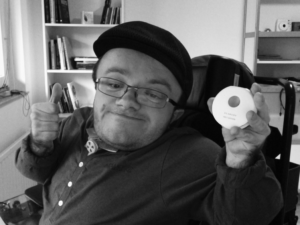In the summer of 2015, I discovered the power of eHealth, albeit under somewhat distressing circumstamces. During my holiday in France, I fell out of my wheelchair, breaking both legs. Given the fact that I have a rare bone disease and don’t speak much French, my medical specialist in the Netherlands sent me a text message telling me what to do. I got treatment for the most pressing injuries in France, then came back to the Netherlands as soon as possible. I’d already photographed the x-rays taken in France and texted these to my specialist. Further treatment could begin as soon as I arrived. At times like these, I think good healthcare is more important than privacy risks. And as far as that’s concerned, there is so much more that could be achieved.
I don’t think it was odd that a French hospital was unable to send x-rays to the Netherlands, but there is still room for improvement here our own country. If I want to take my own x-rays from one hospital to another, they first have to be put on a CD-ROM. I can then take them to my medical specialist, but I can’t see them myself, as they are encrypted. That’s understandable in view of security regulations, but wouldn’t it be better if I, the patient, owned and had access to my own medical data?
Room for improvement in accessing and sharing results
My suggestion for dealing with a situation like mine would be to have a medical portal that I could log on to, to see my x-rays, blood test results and the results of other tests. This would better prepare me for an appointment with my specialist, and also enable me to inform my specialist of any values I could measure at home beforehand (including those for lung tests). Fortunately, hospitals and related parties are working hard to set up and expand their portals so that patients (myself included) can access more and more information.
When I hear how difficult it can be (in my opinion) to get the results of a hospital examination, it really makes me hope that change is possible over the next few years. Yes, I understand that doctors would rather give patients their results personally so that they can explain them at the same time, but for patients to have to wait 14 days? Wouldn’t it be better, when possible, to let patients see the results immediately? It would certainly contribute to their well-being. People sometimes worry themselves sick about something which, ultimately, is far less serious than they first thought. Just the knowledge that certain results are okay can in itself evoke a sense of calm.
Virtual Reality? Let’s keep it real!
I think that eHealth gets a bad name when gadgets are used for their own sake, and technology just for technology’s sake, when in fact eHealth should be used to enhance the care process. One good example is a cycle computer I saw a couple of months ago. People who can’t get out of the house much can ‘go cycling’ in their homes. The screen in front of the bike makes it look as if the user is cycling outdoors, in the countryside or in a city of their choice. It offers so many possibilities. It widens the surrounding for people whose world is generally becoming smaller (e.g. due to old age). The same applies for ‘cuddle robots’. These keep elderly people company, can hold a general conversation with them and respond to touch (stroking).
Building trust by sharing experiences
Another example of eHealth is that of online communities. Communities based around specific themes such as artificial respiration, assistive devices, and the ‘young and handicapped’ are sprouting up everywhere. I have benefited greatly from being able to easily share experiences that relate to my handicap, and doing so helps me and other people to learn and to stay informed. As far as I’m concerned, these communities really are the modern successor to patient associations. I see a new kind of interaction that just doesn’t usually happen with ‘normal’ patient associations. I don’t really mind that communities like these are not limited to just one handicap, given the fact that many issues (applying for assistive resources, dealing with lack of energy) are equally relevant to people with all manner of handicaps.
These communities will also give eHealth a boost in the future, because information about assistive devices and other life-simplifying applications can be shared easily and quickly. Unfortunately, doctors are still hesitant about the use of eHealth, but it can gain significant ground through a bottom-up approach. And that’s a good thing, because it seems clear to me that eHealth is here to stay! Major telephone manufacturers are integrating many health-related services into their smartphones, and at the same time there is a trend towards people staying in their own home as long as they can, and eHealth is making this possible!

